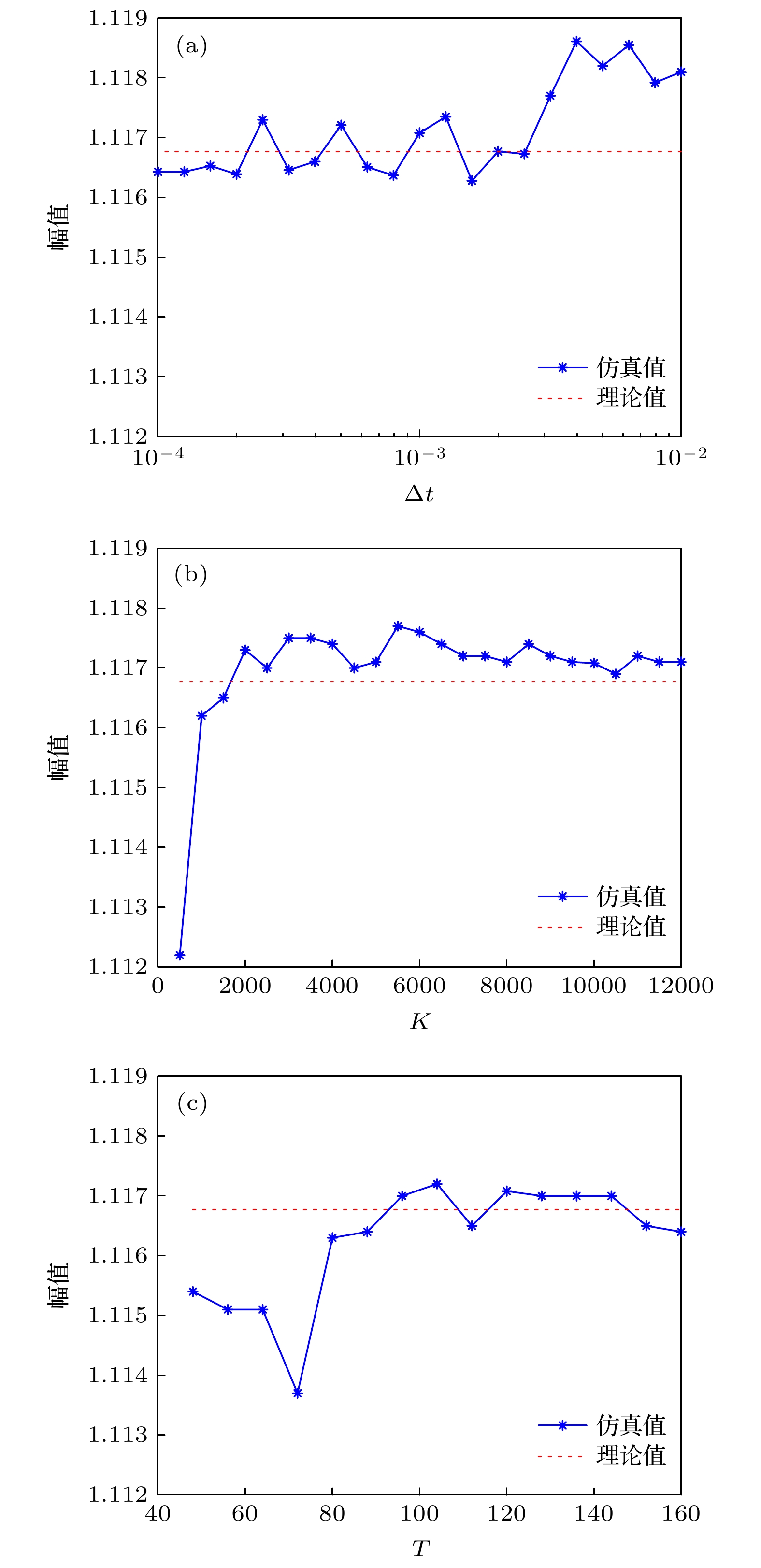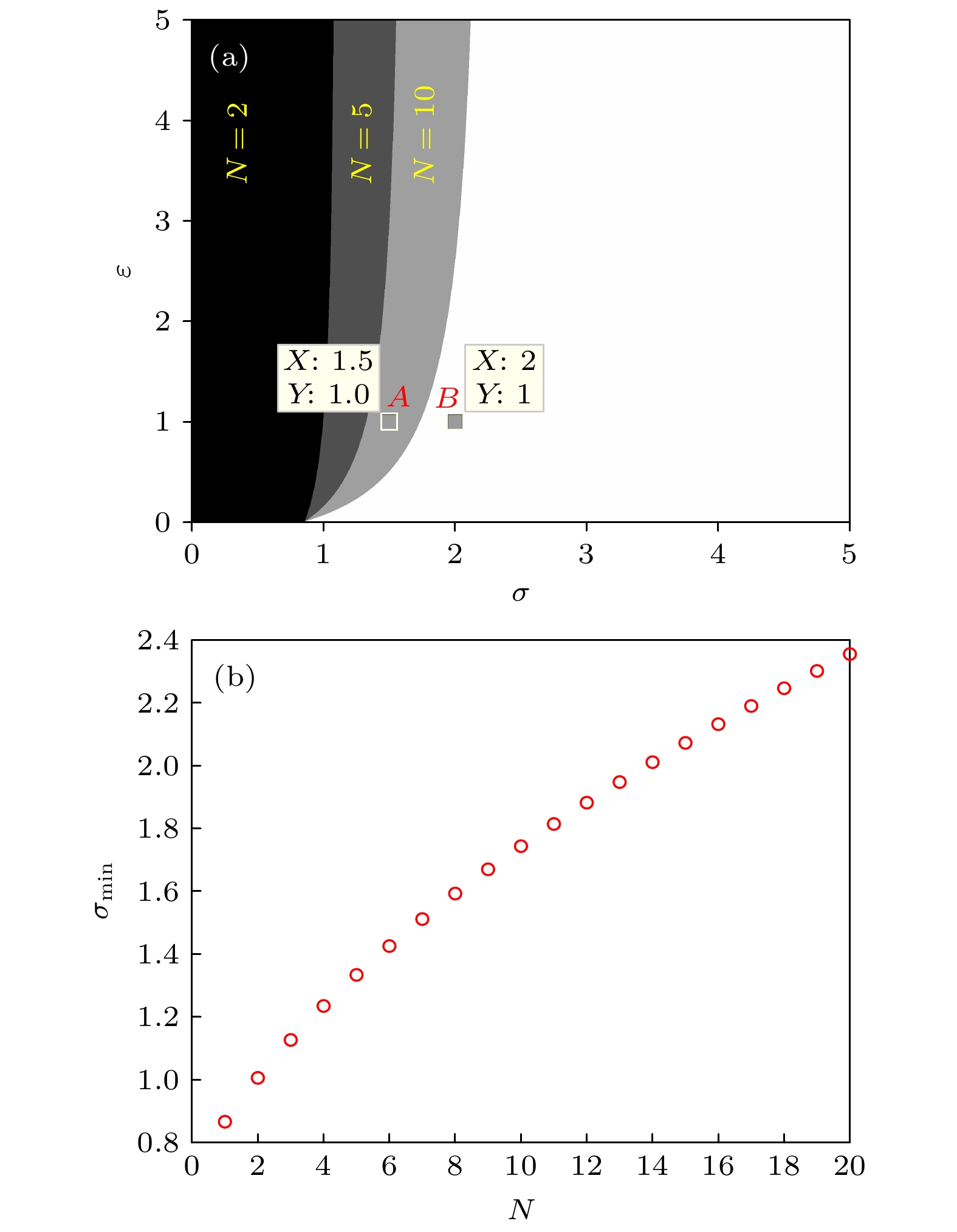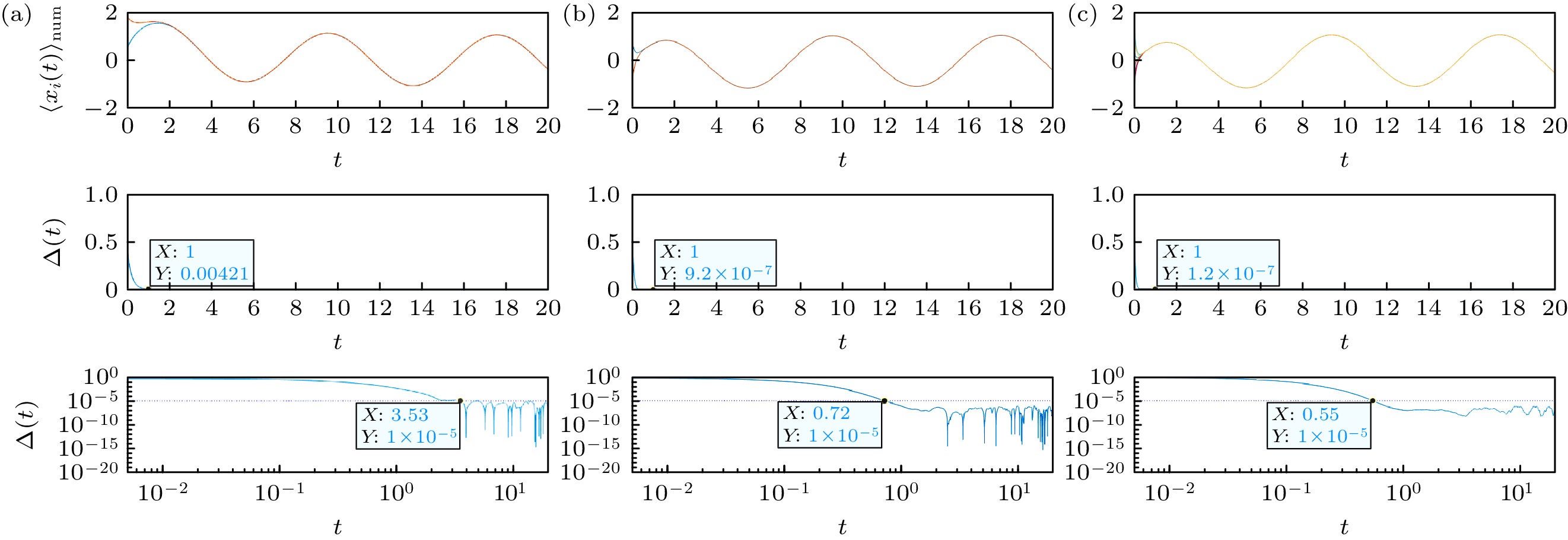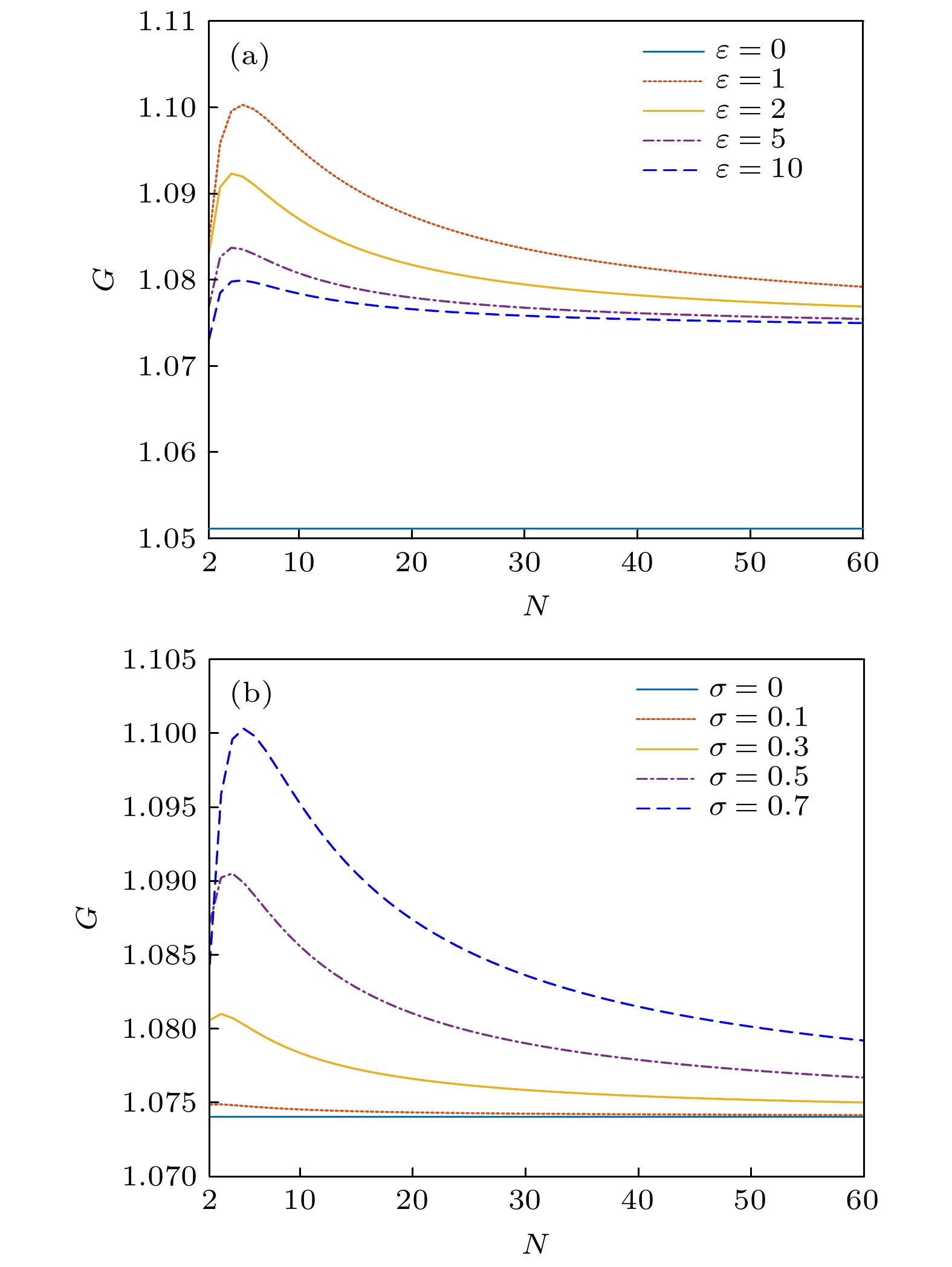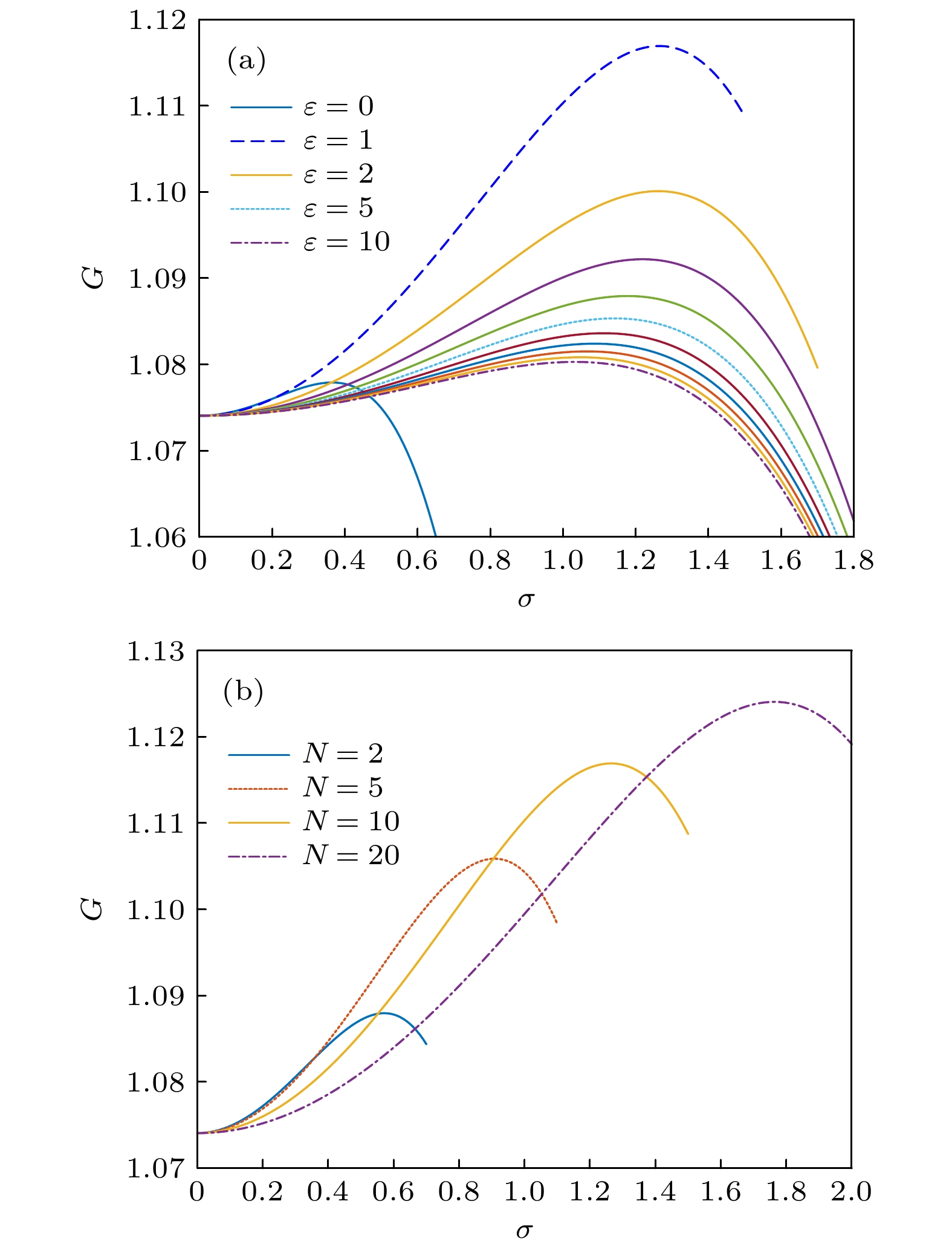-
For multi-particle coupled systems, the effects of environmental fluctuations on each particle are often different in actual situations. To this end, this paper studies the collective dynamic behaviors in globally coupled harmonic oscillators driven by different frequency fluctuations, including synchronization, stability and stochastic resonance (SR). The statistical synchronicity between particles' behaviors is derived by reasonably grouping variables and using random average method, and then the statistical equivalence between behaviors of mean field and behaviors of single particle is obtained. Therefore, the characteristics of mean field's behaviors (that is, collective behaviors) can be obtained by studying behaviors of any single particle. Moreover, the output amplitude gain and the necessary and sufficient condition for the system stability are obtained by using this synchronization. The former lays a theoretical foundation for analyzing the stochastic resonance behavior of the system, and the latter gives the scope of adaptation of the conclusions in this paper. In terms of numerical simulation, the research is mainly carried out through the stochastic Taylor expansion algorithm. Firstly, the influence of system size N and coupling strength
$\varepsilon$ on the stability area and synchronization time is analyzed. The results show that with the increase of the coupling strength$\varepsilon$ or the increase of the system size N, the coupling force between particles increases, and the orderliness of the system increases, so that the stable region gradually increases and the synchronization time gradually decreases. Secondly, the stochastic resonance behavior of the system is studied. Noises provide randomness for the system, and coupling forces provide orderliness for the system. The two compete with each other, so that the system outputs about the noise intensity$\sigma$ , the coupling strength$\varepsilon$ and the system size N exhibit stochastic resonance behavior. As the coupling strength increases or the system size increases, the orderliness of the system increases, and greater noise intensity is required to provide stronger randomness to achieve optimal matching with it, so as to the resonance of the noise intensity$\sigma$ , the peak gradually shifts to the right. Conversely, as the noise intensity$\sigma$ increases, the resonance peak of the coupling strength$\varepsilon$ and the system size N will also shift to the right.-
Keywords:
- stochastic resonance /
- globally coupled harmonic oscillators /
- synchronization /
- stability
[1] Boccaletti S, Latora V, Moreno Y, Chavez M, Hwang D U 2006 Phys. Rep. 424 175
 Google Scholar
Google Scholar
[2] He W, Cao J 2010 IEEE Trans. Neural Networks 21 571
 Google Scholar
Google Scholar
[3] Yang B, Zhang X, Zhang L, Luo M K 2016 Phys. Rev. E 94 022119
[4] Ioannou P J, Farrell B F 2006 Application of Generalized Stability Theory to Deterministic and Statistical Prediction (New York: Cambridge University Press) pp113−126
[5] Dorf R C, Bishop R H 2010 Modern Control Systems (12th Ed.) (Pearson: Prentice Hall) p387
[6] Watts D J, Strogatz S H 1998 Nature 339 440
[7] Pikovsky A, Rosenblum M, Kurths J 2001 Synchronization: A Universal Concept in Nonlinear Sciences (New York: Cambridge University Press) pp1−7
[8] 郑志刚 2019 复杂系统的涌现动力学—从同步到集体输运(上卷) (北京: 科学出版社) 第107页
Zheng Z G 2019 Emergence Dynamics in Complex System: from Synchronization to Collective Transport (Vol. 1) (Beijing: Science Press) p107 (in Chinese)
[9] Benzi R, Sutera A, Vulpiani A 1981 J. Phys. A 14 L453
 Google Scholar
Google Scholar
[10] Benzi R, Parisi G, Sutera A, Vulpiani A 1982 Tellus 34 10
[11] Nicolis C 1982 Tellus 34 1
[12] Inchiosa M E, Bulsara A R 1996 Phys. Rev. E 53 R2021
 Google Scholar
Google Scholar
[13] McDonnell M D, Abbott D 2009 PLoS Comput. Biol. 5 e1000348
 Google Scholar
Google Scholar
[14] Gitterman M 2005 Phys. A 352 309
 Google Scholar
Google Scholar
[15] Gammaitoni L, Hänggi P, Jung P, Marchesoni F 1998 Rev. Mod. Phys. 70 223
[16] McNamara B, Wiesenfeld K 1989 Phys. Rev. A 39 4854
 Google Scholar
Google Scholar
[17] Fox R F 1989 Phys. Rev. A 39 4148
 Google Scholar
Google Scholar
[18] Gang H, Ditzinger T, Ning C Z, Haken H 1993 Phys. Rev. Lett. 71 807
 Google Scholar
Google Scholar
[19] Tessone C J, Mirasso C R, Toral R, Gunton J D 2006 Phys. Rev. Lett. 97 194101
 Google Scholar
Google Scholar
[20] Atsumi Y, Hata H, Nakao H 2013 Phys. Rev. E 88 052806
 Google Scholar
Google Scholar
[21] Tang Y, Zou W, Lu J, Kurths J 2012 Phys. Rev. E 85 046207
 Google Scholar
Google Scholar
[22] Pikovsky A, Zaikin A, de la Casa M A 2002 Phys. Rev. Lett. 88 050601
 Google Scholar
Google Scholar
[23] Cubero D 2008 Phys. Rev. E 77 021112
 Google Scholar
Google Scholar
[24] Li J H 2002 Phys. Rev. E 66 031104
 Google Scholar
Google Scholar
[25] Li J H, Han Y X 2006 Phys. Rev. E 74 051115
 Google Scholar
Google Scholar
[26] Li J H, Han Y X 2007 Commun. Theor. Phys. 47 672
 Google Scholar
Google Scholar
[27] Jiang S, Guo F, Zhou Y, Gu T 2007 Phys. A 375 483
 Google Scholar
Google Scholar
[28] Li J H 2011 Chaos 21 043115
 Google Scholar
Google Scholar
[29] He G T, Tian Y, Wang Y 2013 J. Stat. Mech. 2013 P09026
 Google Scholar
Google Scholar
[30] He G T, Luo R Z, Luo M K 2013 Phys. Scr. 88 065009
 Google Scholar
Google Scholar
[31] Yu T, Zhang L, Luo M K 2013 Phys. Scr. 88 045008
 Google Scholar
Google Scholar
[32] He G T, Tian Y, Luo M K 2014 J. Stat. Mech. 2014 P05018
 Google Scholar
Google Scholar
[33] Zhong S C, Ma H, Peng H, Zhang L 2015 Nonlinear Dyn. 82 535
 Google Scholar
Google Scholar
[34] Berdichevsky V, Gitterman M 1996 Europhys. Lett. 36 161
 Google Scholar
Google Scholar
[35] Chandrasekhar S 1943 Rev. Mod. Phys. 15 1
 Google Scholar
Google Scholar
[36] Fulinski A 1993 Phys. Lett. A 180 94
 Google Scholar
Google Scholar
[37] Robertson B and Astumian R D 1991 J. Chem. Phys. 94 7414
 Google Scholar
Google Scholar
[38] Kubo R 1963 J. Math. Phys. 4 174
 Google Scholar
Google Scholar
[39] Jiang S Q, Hou M J, Jia C H, He J R, Gu T X 2009 Chin. Phys. B 18 2667
 Google Scholar
Google Scholar
[40] Nicolis C, Nicolis G 2017 Phys. Rev. E 96 042214
 Google Scholar
Google Scholar
[41] Yu T, Zhang L., Zhong S C, Lai L 2019 Nonlinear Dyn. 96 1735
 Google Scholar
Google Scholar
[42] Droste F, Lindner B 2014 Biol. Cybern. 108 825
 Google Scholar
Google Scholar
[43] Reimann P, Elston T C 1996 Phys. Rev. Lett. 77 5328
 Google Scholar
Google Scholar
[44] Si M, Conrad N, Shin S, Gu J, Zhang J, Alam M, Ye P 2015 IEEE Trans. Electron Devices 62 3508
 Google Scholar
Google Scholar
[45] Van Den Broeck C 1983 J. Stat. Phys. 31 467
 Google Scholar
Google Scholar
[46] Astumian R D, Bier M 1994 Phys. Rev. Lett. 72 1766
 Google Scholar
Google Scholar
[47] Li J H, Huang Z Q 1998 Phys. Rev. E 57 3917
 Google Scholar
Google Scholar
[48] Bier M 1997 Contemp. Phys. 38 371
 Google Scholar
Google Scholar
[49] Pleiss J, Jähnig F 1991 Biophys. J. 59 795
 Google Scholar
Google Scholar
[50] Li J H, Chen Q H, Zhou X F 2010 Phys. Rev. E 81 041104
 Google Scholar
Google Scholar
[51] Wang Q, Perc M, Duan Z, Chen G 2009 Chaos 19 023112
 Google Scholar
Google Scholar
[52] Hendricks A G, Epureanu B I, Meyhofer E 2009 Phys. Rev. E 79 031929
 Google Scholar
Google Scholar
[53] Stukalin E B, Phillips III H, Kolomeisky A B 2005 Phys. Rev. Lett. 94 238101
 Google Scholar
Google Scholar
[54] Jiang L, Lai L, Yu T, Luo M K 2021 Chin. Phys. B 30 060502
 Google Scholar
Google Scholar
[55] Shapiro V E, Loginov V M 1978 Phys. A 91 563
 Google Scholar
Google Scholar
[56] 李炯生, 查建国, 王新茂 2010 线性代数 (第二版) (合肥: 中国科学技术大学出版社) 第374−375页
Li J S, Zha J G, Wang X M 2010 Linear Algebra (2nd Ed.) (Hefei: University of Science and Techonology of China Press) pp374−375 (in Chinese)
[57] 陈光大 1983 华中师范学报 2 134
Chen G D 1983 Journal of Central China Teachers College 2 134
[58] Kim C, Lee E K, Talkner P 2006 Phys. Rev. E 73 026101
 Google Scholar
Google Scholar
-
图 1 粒子平均位移及对应频域值的数值仿真结果, 其中
$ \varepsilon=1 $ ,$ A_0=1 $ ,$ \sigma=1.3, N=10 $ ,$ \omega=0.5 $ ,$ \lambda=1 $ ,$\varOmega= $ $ \pi/4$ ,$ \Delta t=10^{-3} $ ,$ K=10^4, T=120 $ Figure 1. The average realization and the corresponding frequency domain representation with
$ \varepsilon=1 $ ,$ A_0=1 $ ,$\sigma=1.3, $ $ N=10$ ,$ \omega=0.5 $ ,$ \lambda=1 $ ,$\varOmega=\pi/4$ ,$ \Delta t=10^{-3} $ ,$K=10^4, $ $ T=120$ .图 2 仿真结果与理论结果对比图, 其中
$\varOmega=\pi/4,\; \omega=0.5,\; $ $ \lambda=1,\; \varepsilon=1, \;A_0=1, \;\sigma=2$ (a)$K=10000, \;T=120$ ;$ {\rm{(b)}} $ $\Delta t=0.001,\; T=120$ ;$ {\rm{(c)}} $ $K=10000, \;\Delta t=0.001$ Figure 2. Comparison of theoretical and simulation results with
$\varOmega=\pi/4, \;\omega=0.5, \;\lambda=1, \;\varepsilon=1,\; A_0=1,\; \sigma=2$ :$ {\rm{(a)}} $ $K= 10000,\; T=120$ ;$ {\rm{(b)}} $ $\Delta t=0.001,\; T=120$ ;$ {\rm{(c)}} $ $K= 10000, \;\Delta t=0.001$ .图 3
$ {\rm{(a)}} $ 不同的N所对应的系统稳定性区域, 其中$ \omega=0.5, \lambda=1 $ ;$ {\rm{(b)}} $ 系统稳定性区域边界随N的变化曲线, 其中$ \varepsilon=1 $ , 其他参数同图$ {\rm{(a)}} $ Figure 3.
$ {\rm{(a)}} $ System stability region corresponding to different N with$ \omega=0.5,\; \lambda=1 $ ;$ {\rm{(b)}} $ curve of the boundary of the system stability region with N with$ \varepsilon=1 $ , other parameters are the same as panel$ {\rm{(a)}} $ 图 4 粒子平均位移实现, 其中
$\omega=0.5,\; \lambda=1,\; \varOmega=\pi/4, \; $ $ \varepsilon=1, \;A_0=1,\; N=10$ $ {\rm{(a)}} $ $ \sigma=1.5 $ $ {\rm{(b)}} $ $ \sigma=2 $ Figure 4. The average displacements of particles with
$\omega=0.5,\; \lambda=1,\; \varOmega=\pi/4,\; \varepsilon=1,\; A_0=1,\; N=10$ :$ {\rm{(a)}} $ $\sigma= $ $ 1.5$ ;$ {\rm{(b)}} $ $ \sigma=2 $ .图 5 系统(2)在不同参数条件下的仿真实现和所对应的方差, 其中
$\omega=0.5,\; \lambda=1, \;\sigma=0.7, \;A_0=1,\; \varOmega=\pi/4$ $ {\rm{(a)}} $ $\varepsilon=1, $ $ \; N=2$ ;$ {\rm{(b)}} $ $\varepsilon=4, \;N=2$ ;$ {\rm{(c)}} $ $\varepsilon=1,\; N=10$ . 三幅子图的顶部图中不同颜色的实线代表不同粒子的平均位移Figure 5. The realization of the system (2) under different parameter conditions and the corresponding variance with
$\omega=0.5,\; \lambda=1,\;\sigma=0.7,\; A_0=1,\; \varOmega=\pi/4$ :$ {\rm{(a)}} $ $\varepsilon=1,\; N=2$ ;$ {\rm{(b)}} $ $\varepsilon=4,\; N=2$ ;$ {\rm{(c)}} $ $\varepsilon=1,\; N=10$ . The solid lines in different colors in the first panel of the three subfigure represent the average displacement of different particles.图 7 不同的
$ \sigma $ , N下$ G(\varepsilon) $ 的变化曲线, 其中$\omega=0.5, \; $ $ \lambda=1,\; A_0=1, \;\varOmega=\pi/4$ $ {\rm{(a)}} $ $ N=10 $ ;$ {\rm{(b)}} $ $ \sigma=0.7 $ Figure 7. The curve of
$ G(\varepsilon) $ under different$ \sigma $ and N with$\omega \!= \!0.5,\; \lambda \!= \!1,\; A_0 \!= \!1,\; \varOmega=\pi/4$ :$ {\rm{(a)}} $ $ N \!= \!10 $ ;$ {\rm{(b)}} $ $ \sigma \!= \!0.7 $ 图 8 不同的
$ \sigma $ ,$ \varepsilon $ 下$ G(N) $ 的变化曲线, 其中$\omega=0.5,\; $ $ \lambda=1, \;A_0=1,\; \varOmega=\pi/4$ $ {\rm{(a)}} $ $ \sigma=0.7 $ ;$ {\rm{(b)}} $ $ \varepsilon=1 $ Figure 8. The curve of
$ G(N) $ under different$ \sigma $ and$ \varepsilon $ with$\omega=0.5,\; \lambda=1,\; A_0=1,\; \varOmega=\pi/4$ :$ {\rm{(a)}} $ $ \sigma=0.7 $ ;$ {\rm{(b)}} $ $ \varepsilon=1 $ 图 9 不同的
$ \varepsilon $ , N下$ G(\sigma) $ 的变化曲线, 其中$\omega=0.5, \; $ $ \lambda=1,\; A_0=1,\; \varOmega=\pi/4$ $ {\rm{(a)}} $ $ N=10 $ ;$ {\rm{(b)}} $ $ \varepsilon=1 $ Figure 9. The curve of
$ G(\sigma) $ under different$ \varepsilon $ and N with$\omega=0.5,\; \lambda=1,\; A_0=1, \;\varOmega=\pi/4$ :$ {\rm{(a)}} $ $ N=10 $ ;$ {\rm{(b)}} $ $ \varepsilon=1 $ .表 1 变量表
Table 1. Variable table
乘因子 变量 1 $ \left\langle x_1\right\rangle $ $ \cdots $ $ \left\langle x_i\right\rangle $ $ \cdots $ $ \left\langle x_N\right\rangle $ $ \xi_1 $ $ \left\langle \xi_1 x_1\right\rangle $ $ \cdots $ $ \left\langle \xi_1 x_i\right\rangle $ $ \cdots $ $ \left\langle \xi_1 x_N\right\rangle $ $ \vdots $ $ \vdots $ $ \vdots $ $ \vdots $ $ \xi_{i_1}\xi_{i_2}\cdots\xi_{i_k} $ $ \left\langle \xi_{i_1}\xi_{i_2}\cdots\xi_{i_k}x_1\right\rangle $ $ \cdots $ $ \left\langle \xi_{i_1}\xi_{i_2}\cdots\xi_{i_k}x_i\right\rangle $ $ \cdots $ $ \left\langle \xi_{i_1}\xi_{i_2}\cdots\xi_{i_k}x_N\right\rangle $ $ \vdots $ $ \vdots $ $ \vdots $ $ \vdots $ $ \xi_{1}\xi_{2}\cdots\xi_{N} $ $ \left\langle \xi_{1}\xi_{2}\cdots\xi_{N}x_1\right\rangle $ $ \cdots $ $ \left\langle\xi_{1}\xi_{2}\cdots\xi_{N}x_i\right\rangle $ $ \cdots $ $ \left\langle \xi_{1}\xi_{2}\cdots\xi_{N}x_N\right\rangle $ -
[1] Boccaletti S, Latora V, Moreno Y, Chavez M, Hwang D U 2006 Phys. Rep. 424 175
 Google Scholar
Google Scholar
[2] He W, Cao J 2010 IEEE Trans. Neural Networks 21 571
 Google Scholar
Google Scholar
[3] Yang B, Zhang X, Zhang L, Luo M K 2016 Phys. Rev. E 94 022119
[4] Ioannou P J, Farrell B F 2006 Application of Generalized Stability Theory to Deterministic and Statistical Prediction (New York: Cambridge University Press) pp113−126
[5] Dorf R C, Bishop R H 2010 Modern Control Systems (12th Ed.) (Pearson: Prentice Hall) p387
[6] Watts D J, Strogatz S H 1998 Nature 339 440
[7] Pikovsky A, Rosenblum M, Kurths J 2001 Synchronization: A Universal Concept in Nonlinear Sciences (New York: Cambridge University Press) pp1−7
[8] 郑志刚 2019 复杂系统的涌现动力学—从同步到集体输运(上卷) (北京: 科学出版社) 第107页
Zheng Z G 2019 Emergence Dynamics in Complex System: from Synchronization to Collective Transport (Vol. 1) (Beijing: Science Press) p107 (in Chinese)
[9] Benzi R, Sutera A, Vulpiani A 1981 J. Phys. A 14 L453
 Google Scholar
Google Scholar
[10] Benzi R, Parisi G, Sutera A, Vulpiani A 1982 Tellus 34 10
[11] Nicolis C 1982 Tellus 34 1
[12] Inchiosa M E, Bulsara A R 1996 Phys. Rev. E 53 R2021
 Google Scholar
Google Scholar
[13] McDonnell M D, Abbott D 2009 PLoS Comput. Biol. 5 e1000348
 Google Scholar
Google Scholar
[14] Gitterman M 2005 Phys. A 352 309
 Google Scholar
Google Scholar
[15] Gammaitoni L, Hänggi P, Jung P, Marchesoni F 1998 Rev. Mod. Phys. 70 223
[16] McNamara B, Wiesenfeld K 1989 Phys. Rev. A 39 4854
 Google Scholar
Google Scholar
[17] Fox R F 1989 Phys. Rev. A 39 4148
 Google Scholar
Google Scholar
[18] Gang H, Ditzinger T, Ning C Z, Haken H 1993 Phys. Rev. Lett. 71 807
 Google Scholar
Google Scholar
[19] Tessone C J, Mirasso C R, Toral R, Gunton J D 2006 Phys. Rev. Lett. 97 194101
 Google Scholar
Google Scholar
[20] Atsumi Y, Hata H, Nakao H 2013 Phys. Rev. E 88 052806
 Google Scholar
Google Scholar
[21] Tang Y, Zou W, Lu J, Kurths J 2012 Phys. Rev. E 85 046207
 Google Scholar
Google Scholar
[22] Pikovsky A, Zaikin A, de la Casa M A 2002 Phys. Rev. Lett. 88 050601
 Google Scholar
Google Scholar
[23] Cubero D 2008 Phys. Rev. E 77 021112
 Google Scholar
Google Scholar
[24] Li J H 2002 Phys. Rev. E 66 031104
 Google Scholar
Google Scholar
[25] Li J H, Han Y X 2006 Phys. Rev. E 74 051115
 Google Scholar
Google Scholar
[26] Li J H, Han Y X 2007 Commun. Theor. Phys. 47 672
 Google Scholar
Google Scholar
[27] Jiang S, Guo F, Zhou Y, Gu T 2007 Phys. A 375 483
 Google Scholar
Google Scholar
[28] Li J H 2011 Chaos 21 043115
 Google Scholar
Google Scholar
[29] He G T, Tian Y, Wang Y 2013 J. Stat. Mech. 2013 P09026
 Google Scholar
Google Scholar
[30] He G T, Luo R Z, Luo M K 2013 Phys. Scr. 88 065009
 Google Scholar
Google Scholar
[31] Yu T, Zhang L, Luo M K 2013 Phys. Scr. 88 045008
 Google Scholar
Google Scholar
[32] He G T, Tian Y, Luo M K 2014 J. Stat. Mech. 2014 P05018
 Google Scholar
Google Scholar
[33] Zhong S C, Ma H, Peng H, Zhang L 2015 Nonlinear Dyn. 82 535
 Google Scholar
Google Scholar
[34] Berdichevsky V, Gitterman M 1996 Europhys. Lett. 36 161
 Google Scholar
Google Scholar
[35] Chandrasekhar S 1943 Rev. Mod. Phys. 15 1
 Google Scholar
Google Scholar
[36] Fulinski A 1993 Phys. Lett. A 180 94
 Google Scholar
Google Scholar
[37] Robertson B and Astumian R D 1991 J. Chem. Phys. 94 7414
 Google Scholar
Google Scholar
[38] Kubo R 1963 J. Math. Phys. 4 174
 Google Scholar
Google Scholar
[39] Jiang S Q, Hou M J, Jia C H, He J R, Gu T X 2009 Chin. Phys. B 18 2667
 Google Scholar
Google Scholar
[40] Nicolis C, Nicolis G 2017 Phys. Rev. E 96 042214
 Google Scholar
Google Scholar
[41] Yu T, Zhang L., Zhong S C, Lai L 2019 Nonlinear Dyn. 96 1735
 Google Scholar
Google Scholar
[42] Droste F, Lindner B 2014 Biol. Cybern. 108 825
 Google Scholar
Google Scholar
[43] Reimann P, Elston T C 1996 Phys. Rev. Lett. 77 5328
 Google Scholar
Google Scholar
[44] Si M, Conrad N, Shin S, Gu J, Zhang J, Alam M, Ye P 2015 IEEE Trans. Electron Devices 62 3508
 Google Scholar
Google Scholar
[45] Van Den Broeck C 1983 J. Stat. Phys. 31 467
 Google Scholar
Google Scholar
[46] Astumian R D, Bier M 1994 Phys. Rev. Lett. 72 1766
 Google Scholar
Google Scholar
[47] Li J H, Huang Z Q 1998 Phys. Rev. E 57 3917
 Google Scholar
Google Scholar
[48] Bier M 1997 Contemp. Phys. 38 371
 Google Scholar
Google Scholar
[49] Pleiss J, Jähnig F 1991 Biophys. J. 59 795
 Google Scholar
Google Scholar
[50] Li J H, Chen Q H, Zhou X F 2010 Phys. Rev. E 81 041104
 Google Scholar
Google Scholar
[51] Wang Q, Perc M, Duan Z, Chen G 2009 Chaos 19 023112
 Google Scholar
Google Scholar
[52] Hendricks A G, Epureanu B I, Meyhofer E 2009 Phys. Rev. E 79 031929
 Google Scholar
Google Scholar
[53] Stukalin E B, Phillips III H, Kolomeisky A B 2005 Phys. Rev. Lett. 94 238101
 Google Scholar
Google Scholar
[54] Jiang L, Lai L, Yu T, Luo M K 2021 Chin. Phys. B 30 060502
 Google Scholar
Google Scholar
[55] Shapiro V E, Loginov V M 1978 Phys. A 91 563
 Google Scholar
Google Scholar
[56] 李炯生, 查建国, 王新茂 2010 线性代数 (第二版) (合肥: 中国科学技术大学出版社) 第374−375页
Li J S, Zha J G, Wang X M 2010 Linear Algebra (2nd Ed.) (Hefei: University of Science and Techonology of China Press) pp374−375 (in Chinese)
[57] 陈光大 1983 华中师范学报 2 134
Chen G D 1983 Journal of Central China Teachers College 2 134
[58] Kim C, Lee E K, Talkner P 2006 Phys. Rev. E 73 026101
 Google Scholar
Google Scholar
Catalog
Metrics
- Abstract views: 3487
- PDF Downloads: 82
- Cited By: 0
















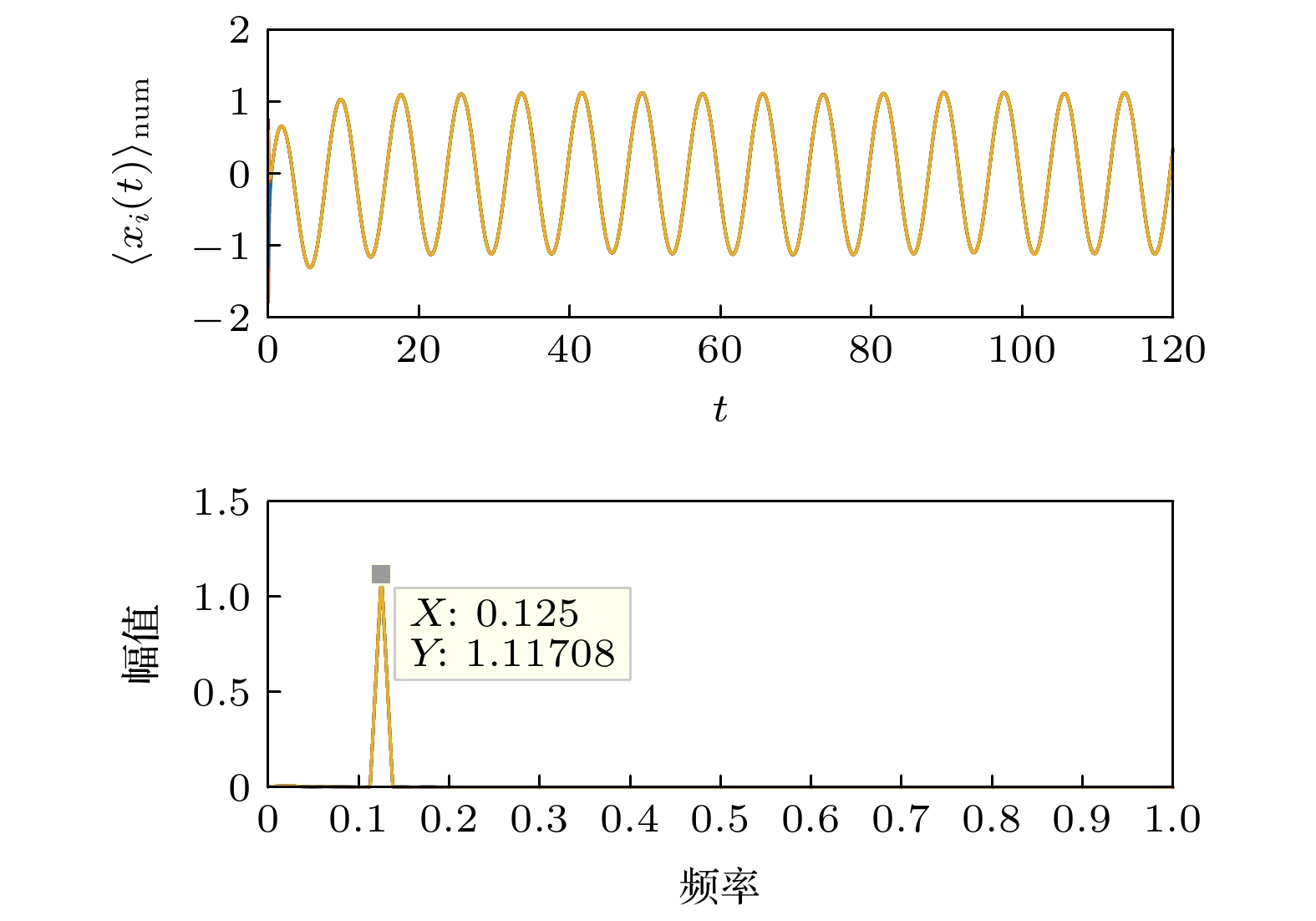



















 DownLoad:
DownLoad:
